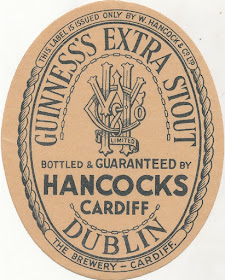I say an interesting table. Actually, there were two of them.
| UK beer imports 1950 - 1952 | ||||||
| Month ended December | Twelve Months ended December | |||||
| 1950 | 1951 | 1952 | 1950 | 1951 | 1952 | |
| Bulk- Barrels | 92,432 | 110,068 | 114,488 | 1,053,293 | 1,056,240 | 1,064,788 |
| Value | £439,952 | £533,341 | £657,494 | £4,941,434 | £5,168,840 | £6,138,665 |
| Source: | ||||||
| Brewer's Guardian 1953, 1953, February page 80. | ||||||
Looking at the bare figures, it seems that the UK was importing a considerable amount of beer – around four times as much as it exported. But the figures aren’t what they at first appear. That becomes obvious when you see the imports broken down by country of origin.
| UK beer imports in November 1952 | ||
| Country whence consigned | Quantity Bulk Barrels | Value £ |
| Australia | 6 | |
| Canada | 3 | |
| Irish Republic | 80,473 | 454,488 |
| Germany (Western) | 125 | 1,818 |
| Sweden | 5 | 85 |
| Denmark | 1,873 | 22,398 |
| Netherlands | 666 | 6,478 |
| Belgium | 107 | 1,931 |
| Czechoslovakia | 51 | 383 |
| Total | 83,300 | 487,590 |
| Source: | ||
| Brewer's Guardian 1953, 1953, February page 83. | ||
The overwhelming majority of the imports came from the Republic of Ireland, presumably almost all in the form of Guinness Extra Stout. Multiplying the November figure by 12, gives a rough idea of the figures on an annual basis. You’ll see that the total is pretty close to the real figure for 1952:
| UK beer imports in 1952 | ||
| Country | bulk barrels | % |
| Irish Republic | 965,676 | 96.61% |
| Germany (Western) | 1,500 | 0.15% |
| Sweden | 60 | 0.01% |
| Denmark | 22,476 | 2.25% |
| Netherlands | 7,992 | 0.80% |
| Belgium | 1,284 | 0.13% |
| Czechoslovakia | 612 | 0.06% |
| Total | 999,600 | |
| Source: | ||
| Brewer's Guardian 1953, 1953, February page 83. | ||
The only countries that were exporting any sort of volume to the UK, other than Ireland, were Denmark and the Netherlands. This time in the form of Carlsberg, Tuborg and Heineken Pils. The total of European imports I get to be just under 34,000 annually. Presumably pretty much 100% Lager.
That gives you some idea of the small size of the UK Lager market at the time. Only a handful of British breweries produced Lager at this date: Wrexham, Tennent, Red Tower, Barclay Perkins and the Alloa Brewery. Total sales couldn’t have been more than a couple of hundred thousand barrels a year. At a time when consumption totalled almost 26 million barrels:
| UK beer production 1950 - 1952 (bulk barrels) | |||
| UK | 1950 | 1951 | 1952 |
| Production | 26,513,997 | 24,891,746 | 25,156,489 |
| Consumption | 27,311,390 | 25,597,793 | 25,850,381 |
| Exports | 221,210 | 275,433 | 267,390 |
| Imports | 1,018,603 | 981,480 | 961,282 |
| Production Irish Republic | 2,304,668 | 2,279,655 | 2,339,224 |
| Sources: | |||
| Brewers' Almanack 1955, p. 50 | |||
| Brewers' Almanack 1955, p. 57 | |||
| Brewers' Almanack 1955, p.107-110 | |||
You can see that getting on for 40% if the Republic of Ireland’s output of beer was exported to the UK. Impressive. Especially as Guinness had a brewery in London churning out almost 1 million barrels a year.

What amazes me is that two generations of brewers in Wrexham brewed and advocated lagers and probably died of old age before ever seeing the most popular beer in Britain ever catch on...
ReplyDeletePet historical peeve: "The Irish Republic" was the name of the entity declared by the rebels in 1916 and was never a legal entity in any real sense, though was recognised retrospectively by subsequent Irish governments. It ceased to exist in any form in 1922 with the creation of the Irish Free State, which in turn was replaced by the Republic in 1949.
ReplyDeleteThe BBC still uses "the Irish Republic" to describe the state. Bugs the hell out of me.